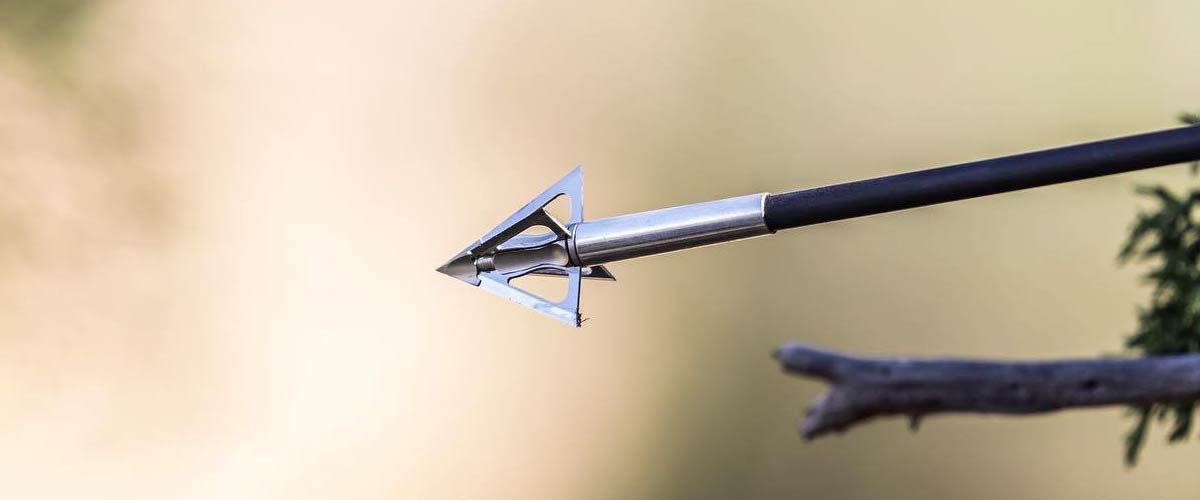How to Select the Correct
Broadhead for Hunting
By Larry McCoy |

As hunting technology continues to grow, it’s increasingly important to select the right gear for the job at hand. This is especially true for the ends of your arrows. There are many types of broadheads available today, and each is purpose-built for different applications. Being aware of your hunting situation and selecting the right broadhead for your game is critically important. While some aspects of broadhead choice do come down to personal preference, there are also some rules and guidelines that should be observed when selecting a broadhead.
Fixed Blade vs Mechanical BroadheadsFixed broadheads are built with a head that is fixed in place and supported by blades for the entire length of the ferrule. This provides fixed broadheads with a lot of structural strength. Because the blades have no moving parts that could malfunction, fixed blade broadheads provide very reliable penetration.
You can either use replaceable blade broadheads or single-piece broadheads. Replaceable blade broadheads tend to last longer, because you can reuse the body of the broadhead as long as it is not damaged. Singe piece broadheads are more rigid (and thus stronger), but the entire broadhead can be rendered useless if any blade is damaged. Once a single-piece broadhead blade has been damaged, it will be extremely difficult to regain an even edge.
Chisel Point
Chisel point broadheads are a time-tested option that have been popular all throughout modern bow hunting. Since they are reusable, chisel point designs are popular for use with whitetail and elk. This is because chisel point broadheads can handle hitting tough bones and ligaments without deflecting or being damaged. A chisel point opens the hide upon impact, helping the arrow to stay on course as it penetrates the game.
Cut-On-Impact
As soon as a cut-on-impact broadhead hits the target, it begins slicing through the hide. Because cut-on-impact broadheads first bore a hole before penetrating, they allow the arrow to push further into the animal. If your gear is not providing ample energy for deep penetration, a cut-on-impact broadhead may be a great solution. These are popular with hunters who use recurve and longbows that have lower poundage. When hunting animals in the upper levels of the big game spectrum (like elk, moose, and other large predators), cut-on-impact broadheads could also be a good choice. These animals have thick hides and heavy bones, and a cut-on-impact broadhead will prevent your arrow from slowing down on impact.
Mechanical Broadheads
As hunting technology continues to advance, mechanical broadheads are becoming more and more popular. Mechanical broadheads open upon impact, providing a very wide cutting surface. This opening motion makes a much more significant impact on the target than fixed blade broadheads. Mechanical broadheads are also considered more accurate than fixed-blade broadheads Unfortunately, mechanical broadheads do tend to lose energy on impact. You will need to shoot a higher poundage bow and a heavier arrow to ensure the broadhead will open consistently. As a rule of thumb, your bow should have a draw weight of at least 60 lbs if you’re using mechanical broadheads.
Choosing the Proper Broadhead for Your Game
There are many factors to take into account when choosing a broadhead, but the type of animal you’ll be hunting is one of the most important. Different types of game will have different types of anatomy. Larger species will have wider chest cavities and thicker hides. These will require broadheads with more penetrative power.
Deer Hunting Broadheads
If you are game with smaller chest cavities, like deer or antelope, a chisel-point broadhead is ideal. These will give you plenty of penetration to achieve full pass-through shots. With replaceable blades, you will also be able to use the same broadheads for many years.
However, if you are hunting these same animals with a relatively short shot distance (less than thirty yards), you will also want to reduce energy loss as much as possible. Mechanical broadheads will conserve energy and create ideal, extra-wide wound holes.
Big Game Hunting Broadheads
Larger game like elk and moose will have equally large body cavities. To penetrate these and provide enough stopping power, you should use a cut-on-impact broadhead. The arrow needs to penetrate through both sides of the vital organs for a humane kill. A cut-on-impact broadhead will reduce energy loss upon impact, allowing your arrow to penetrate sufficiently into large body cavities.
Some elk can be effectively stopped with mechanical broadheads, but for large predators like moose and bear, you should use the strongest fixed-blade broadhead that you can find. You will need the extra rigidity to penetrate through these animals’ hides.
Matching Your Arrow to Your Broadhead
Having the right broadhead is important, but your arrow must also match your broadhead. If your arrow is too light, it will reduce your penetration. For big game hunting, your arrow should fall between 8.5 and 10.5 grains per inch with a minimum of a 400 spine. This will give any broadhead plenty of force to sufficiently push through your target.
The Importance of Broadheads
It’s critical to choose the right broadhead for the animal you’ll be hunting. While there are plenty of options, they are not all ideal for every scenario. Use these tips to pick your broadheads before your next hunting excursion.